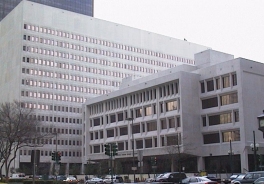Tuesday, we posted the FBI affidavit detailing why four suspects were arrested “for the purpose of interfering with the phone system” at U.S. Senator Mary Landrieu’s office.
The details of their outfits caught my attention.
“Flanagan and Basel entered the Hale Boggs Federal Building, each dressed in blue denim pants, a blue work shirt, a light fluorescent green vest, a tool belt and carrying white construction-style hard hats.”
It sounds like something from the Village People.
With an eye to style and authenticity, I wondered when was the last time anyone saw a lineman from the phone company showing up to check on your phone line? Like the milkman or the encyclopedia salesman, I assume the sightings of telephone repairmen are rare these days. In fact, my landline was dysfunctional recently and I made a call to AT&T to report it and they told me to, in so many words, fix it myself.
How on earth do you fake your way into a federal building? A quick glance at the roster of offices housed there suggests you better treat a trip to the Hale Boggs building like an international flight and expect the security there to match any airport setup.
In addition to Landrieu’s office, the building is home to the U.S. attorney’s office, the U.S. Department of Homeland Security, the Housing and Urban Development office plus the U.S District Court. The job of securing the building is not for your average mall cop.
I have visited the building several times over the past few years, and ever since my first run-in with the security, I usually clean out my purse the night before — just in case I have some incriminating evidence from some night on the town that I have not had, nor will ever have. Honest. I swear.
Approaching security in that building encourages all the little paranoid demons that live in your head. It exists on the same plane as checking your rear view mirror for the blue lights after you pass a cop car. You don’t know what you did, but you’re sure they are going to get you for it.
In January of 2008, I was scheduled to attend a hearing before Judge Martin Feldman. The issue at hand was the reckless manner in which the city was proceeding with the demolition of private property and whether or not due process was being afforded these homeowners.
I left the house with my camera in my bag as I do every day, not thinking about the security regulations.
On first pass, one of the three security guards denied my entry and gave me firm direction to leave the building. I asked if I could stow the camera there at security and knew immediately I would be denied.
With great haste and more than a little anxiety, I ran out and bumped into Davida Finger, the plaintiffs’ attorney. I thought that perhaps as legal counsel, she could pass by security and claim the camera as her own. She disabused me of that notion and sent one of the students attending the hearing off to a nearby lunch counter to stow the camera. Happily, I got it back. Unhappily, I foolishly repeated the mistake a few months later and had to hide the camera in a trashcan.
The moral of the story is that security at the building is tight – and it should be. But the question remains: How did they enter the building without presenting proper credentials on the first floor and what protocols will be changed, if any?

